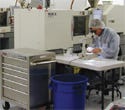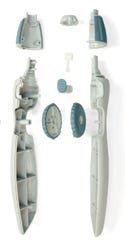July 12, 2008
Originally Published MPMN July 2008
OUTSOURCING OUTLOOK
Cleanroom Manufacturing & Assembly
|
Calvin Koh, marketing manager, Vincent Medical Manufacturing Co., Kowloon, Hong Kong. |
When selecting a cleanroom manufacturer, begin with the basics. First, is the effective area of the cleanroom large enough to manufacture your product, now and in the future? Second, how much of the cleanroom’s space is currently allocated to other projects? Is there enough space available to manufacture your product on the proper scale? Third, does the facility have the necessary certifications to accommodate the FDA class of your product?
Once the OEM has confirmed the suitability of the facility, the validation and quality control processes must be evaluated. The cleanroom should have an available validation report generated during construction, and revalidation reports should be prepared periodically. In addition, the facility should have full test records on file from a recognized third-party laboratory. The cleanroom should have an internal quality control department capable of strictly monitoring the manufacturing environment’s cleanliness and sterility. An in-house microbiological laboratory for quality control can provide greater efficiency, but check that the laboratory operators have been certified by local government.
Finally, take into account the specific requirements of your product. For example, if it’s a plastic disposable medical product, does the cleanroom offer injection molding? Blow molding? Assembly? Packaging? What kinds of packaging does it provide? The largest, most pristine cleanroom won’t be helpful to you if it doesn’t have the capabilities your product requires.
Service Provider Manufactures Tubing in Class 10,000 Cleanrooms
|
Resins and tubing can be manufactured in a variety of configurations in a company’s Class 10,000 cleanrooms. The company specializes in fluoropolymer tubing for catheter applications, capillary tubing, multilumen tubing, microtubing with close tolerances, needle sheaths, and corrugated tubing for oxygen, gas, and fluid transfer. Designed to meet specific application requirements, all custom components are RoHS compliant, chemically inert, and nonleaching, and have nonstick surfaces. Drilling, flaring, flanging, slitting, scoring, hole punching, and cutting processes are available. Etching processes are also available to aid in bonding.
Parker-TexMed, div. of Parflex, Ft. Worth, TX
www.texmed.us
Firm Specializes in Micromanufacturing
|
A company produces dust-speck-sized parts and micro features on standard-size components through processes that occur in a Class 10,000 cleanroom. Precision capabilities enable the fabrication of assembled parts with micron-scale tolerances and mirror-finished optical surfaces. Micromanufacturing services include micromolding, microstamping, specialty plating, and single-point diamond turning; design services are also available. Examples of applications requiring these capabilities are minimally invasive surgical instruments, stent markers, microarrays, microfluidic chips, and neurological, cochlear, and ophthalmic implants.
MicroPep, Providence, RI
www.micropep.com
Company Molds Custom Parts in a Class 10,000 Cleanroom
|
A service provider partners with OEMs to design custom-molded products and manufacturing processes to meet specific project requirements. A specially developed automatic molding press located in the company’s Class 10,000 cleanroom is used for compression and transfer molding operations. The press is computer controlled and monitored to maintain consistent conditions in order to ensure duplication of products through multiple molding cycles. In addition, plastic, insert, and TPE overmolding, as well as subassembly processes, are available.
Da/Pro Rubber Inc., Tulsa, OK
www.daprorubber.com
Molder Offers High-Volume Manufacturing in Cleanrooms
|
Complex medical assemblies are manufactured by a company with rubber and plastic molding capabilities. High-volume production occurs in Class 10,000 and Class 100,000 cleanrooms, and design assistance and materials engineering are available. The firm’s medical device manufacturing experience includes surgical instruments, diagnostic instruments, valves, pumps, connectors, diaphragms, seals, plunger tips, lab equipment, and disposables. Rubber-to-plastic and metal-to-plastic conversions are also offered.
Minnesota Rubber and Plastics, Minneapolis
www.mnrubber.com
Cleanrooms House a Variety of Molding Machines
|
A contract manufacturer of medical devices based in Hong Kong serves clients in the United States, Europe, Japan, and other countries. The company operates a 30,000-sq-m, wholly owned facility in China that includes 1266 sq m of Class 100,000 cleanrooms. Contained in the cleanrooms are 35 injection molding machines, 4 blow molding machines, 4 extrusion machines, and a number of assembly lines. In addition, the plant features a metal-stamping shop, a sewing operation, bilingual documentation packages, and a maximum capacity of 1500 workers. The factory is certified to ISO 9001 standards.
Vincent Medical Manufacturing Co., Kowloon, Hong Kong
www.vincentmedical.com
Copyright ©2008 Medical Product Manufacturing News
You May Also Like








